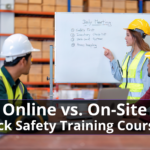
Ensuring the safety and efficiency of your warehouse operations begins with proper training. Choosing the right rack safety and maintenance training course for your team is essential to protect your employees, maintain equipment longevity, and ensure compliance with industry standards.
So far, so simple — right? But with so many options available, how do you pick the right one? In this article, we’ll guide you through the key factors to consider when selecting the best training course to meet your team’s needs.
Understanding the Importance of Rack Safety and Maintenance Training
Before you jump right into the selection process, you’ll need to know why rack safety and maintenance training is so important.
Proper training helps prevent accidents, reduces downtime, and ensures that your racking systems are used and maintained correctly. Without the right knowledge, employees might inadvertently cause damage to racking systems, leading to costly repairs or, worse, serious safety hazards.
Key Benefits of Proper Training
- Reducing the risk of racking collapses or accidents caused by improper handling or maintenance.
- Ensuring that racking systems are regularly inspected and kept in good condition.
- Adhering to industry safety standards and regulations, avoiding potential legal issues.
Assessing your team’s training needs
Now, you’ll need to understand your team’s specific needs. Different teams may require varying levels of training depending on their roles, existing knowledge, and the specific types of racking systems in use.
Questions to Consider
- What is the current skill level of your team? Think about whether your team needs basic, intermediate, or advanced training.
- What types of racking systems are in use? Ensure the course covers the specific systems used in your warehouse.
- What are the common challenges your team faces? Identify areas where your team has struggled or where there have been incidents or near misses.
Action Steps
- Evaluate the current skill level of your team to identify gaps in knowledge and areas needing improvement.
- Determine if your team requires general safety training or more specialised maintenance courses tailored to specific racking systems.
- Based on your assessment, prioritise the training topics most relevant to your team’s needs.
Exploring different types of training courses
Safety training courses vary widely in terms of content, delivery methods, and depth of knowledge. Choosing the right type of course depends on your team’s needs and your operation’s logistical considerations.
In-Person Safety Training
Features:
- Allows for practical, hands-on training with real equipment.
- Provides opportunities for direct interaction with trainers, enabling immediate feedback and clarification.
Best For:
- Teams that benefit from practical exercises and real-world scenarios.
- Operations where direct supervision during training is crucial.
Online Safety Training
Features:
- Offers the ability to learn at one’s own pace and revisit materials as needed.
- Can be accessed from anywhere, making it ideal for teams spread across multiple locations.
Best For:
- Teams that need flexible learning schedules.
- Operations with multiple locations.
Blended Learning
Features:
- Integrates online learning with in-person sessions to offer the best of both worlds.
- Provides both theoretical knowledge and practical skills.
Best For:
- Teams that require a flexible yet thorough training approach.
- Operations looking for a balanced training method that accommodates different learning styles.
Evaluating Course Content and Quality
Not all warehouse training courses are created equal. You’ll need to evaluate the content and quality of a course before enrolling your team.
What to Look For:
- Relevance: Ensure the course content aligns with your specific racking systems and operational needs.
- Depth of Knowledge: Check that the course covers all necessary topics, from basic safety protocols to advanced maintenance techniques.
- Accreditation: Choose courses accredited by recognised industry bodies, such as SEMA (Storage Equipment Manufacturers Association).
Questions to Ask:
- Who are the trainers? Verify that the course is taught by experienced professionals with relevant industry expertise.
- What is the course structure? Ensure that the course is well-organized, with a logical progression from basic concepts to more advanced topics.
- Are there practical components? Look for courses that include hands-on exercises or real-world scenarios to reinforce learning.
Tips for Evaluation:
- Request a Syllabus: Ask for a detailed syllabus or course outline to review before enrolling your team.
- Check Reviews: Look for reviews or testimonials from other companies that have completed the course to gauge its effectiveness.
- Trial Access: Some providers may offer trial access to online courses or sample modules—take advantage of these to assess the course quality.
Considering logistics and flexibility
Selecting a course that fits painlessly into your team’s schedule and operational demands is essential, as otherwise, there will be an inclination to rush through the training or avoid it entirely.
Logistical Considerations
Ensure the course can be scheduled at a time that minimises disruption to your operations, and decide whether in-person training should take place on-site at your warehouse or at a training facility. You’ll also need to think about how much time your team can realistically dedicate to training without impacting productivity.
Flexibility Features
Online courses that allow learners to progress at their own speed can be beneficial for accommodating different schedules, and some of these courses offer customisable content that can be tailored to your specific needs, ensuring that all training is relevant. Be sure to look for courses that provide on-demand access to materials, allowing your team to revisit topics as needed.
Making it Work
Schedule training during off-peak times to minimise operational disruption, and ensure that the necessary resources, such as time and space, are available to support the training. You can also think about using tools like learning management systems (LMS) to track your team’s progress and ensure they are meeting training objectives.
Final Thoughts
Choosing the right rack safety and maintenance training course is an investment in your team’s safety and your warehouse’s efficiency.
You can make a decision that benefits your entire operation by carefully considering your team’s needs, evaluating course content and logistics, and planning the training effectively. For racking inspections and other safety tips for the warehouse, be sure to check out SEE Racking Inspections.





